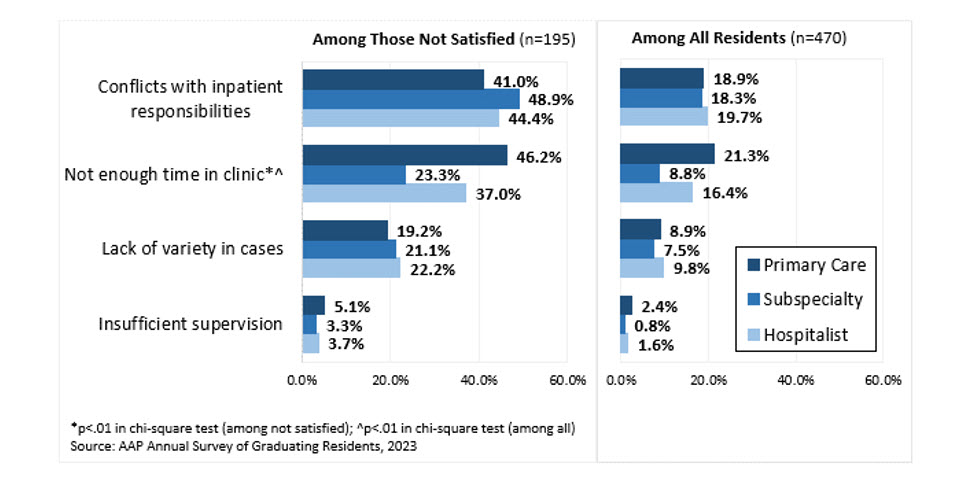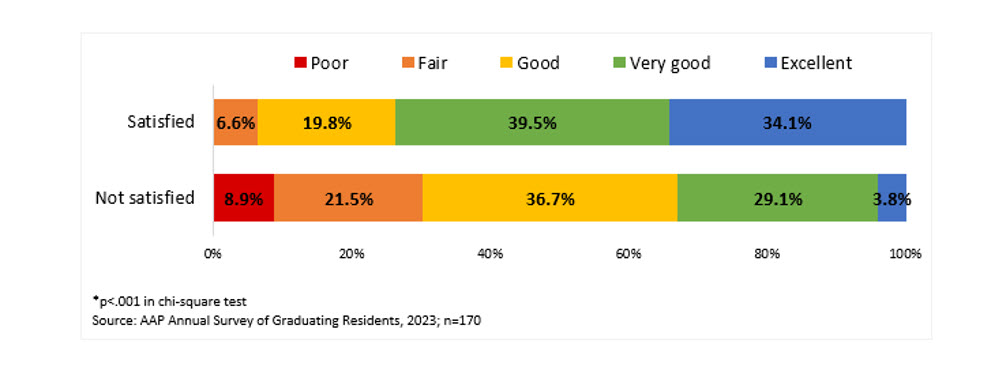Gottschlich E, Kist T, Haftel H
Presented at the 2024 Pediatric Academic Societies Annual Meeting
Background: The continuity clinic experience is an integral part of pediatric resident education.
Objective: Describe graduating pediatric residents’ satisfaction with their continuity clinic schedule and potential reasons for not being satisfied. Among residents with a primary care career goal, examine the relationship of continuity clinic schedule satisfaction and reported preparedness for primary care practice.
Methods: National random sample of 1200 US pediatric residency graduates from the 2023 AAP Annual Survey of Graduating Residents. Respondents reported a future career goal after all training is complete (primary care; subspecialty; hospitalist). Residents also reported if they were satisfied with their continuity clinic schedule (yes/no); those not satisfied were given a list and asked to select the potential reason(s) for not being satisfied. Residents also rated how well their program prepared them (5-point scale, “poor” to “excellent”) for primary care practice. Chi-square tests examined a) variation in satisfaction with continuity clinic schedule by career goal, b) variation in reasons for not being satisfied by career goal, and c) variation in perceived preparedness for primary care practice (poor/fair/good vs very good/excellent) by satisfaction with continuity clinic schedule among those with a primary care career goal.
Results: Survey response was 41% (n=494). A third (36.4%) of residents reported a primary care career goal, 50.7% subspecialty, and 12.9% hospitalist. The majority (58.5%) were satisfied with their continuity clinic schedule, with no significant difference by career goal. Among those not satisfied, almost half selected conflicts with inpatient responsibilities, 1 in 5 selected a lack in variety of cases, and few selected insufficient supervision; the only reason that differed across career goals was not enough time in clinic (a larger percentage of residents with primary care goals (46.2%) selected this than those with hospitalist (37.0%) or subspecialty (23.3%) goals, p<.01; Figure 1). Among residents with a primary care goal, satisfaction with continuity clinic schedule was associated with very good/excellent preparedness for primary care practice (73.6% for satisfied vs 32.9% for not satisfied, p<.001; Figure 2).
Conclusion: Six in 10 graduating residents were satisfied with their continuity clinic schedule. Among residents with a primary care career goal, those who were satisfied with their schedule were more likely to report being prepared for pediatric primary care practice. Future research can examine how continuity clinic scheduling type may relate to satisfaction.
Figure 1. Percentage of Graduating Pediatric Residents Reporting Reasons for Not Being Satisfied with Continuity Clinic Schedule by Career Goal

Figure 2. Preparedness for Primary Care Practice by Satisfaction with Continuity Clinic Schedule Among Graduating Pediatric Residents with a Primary Care Career Goal*

Last Updated
05/21/2024
Source
American Academy of Pediatrics